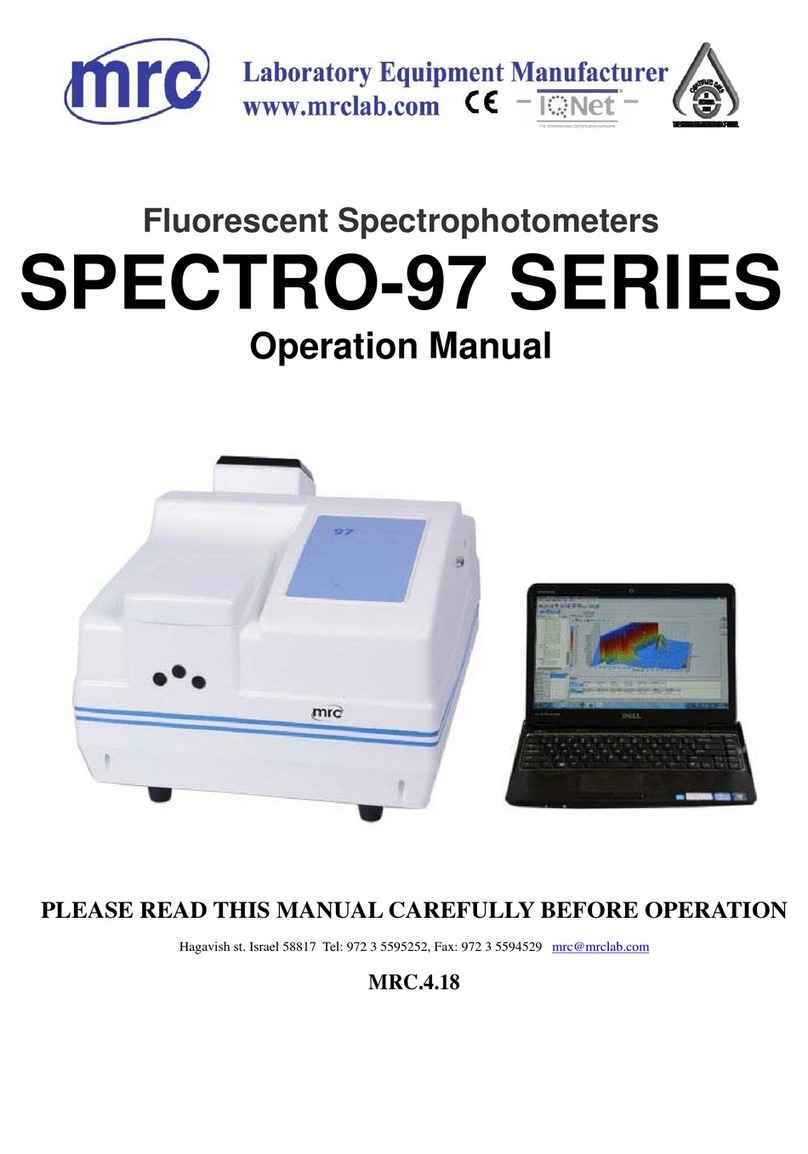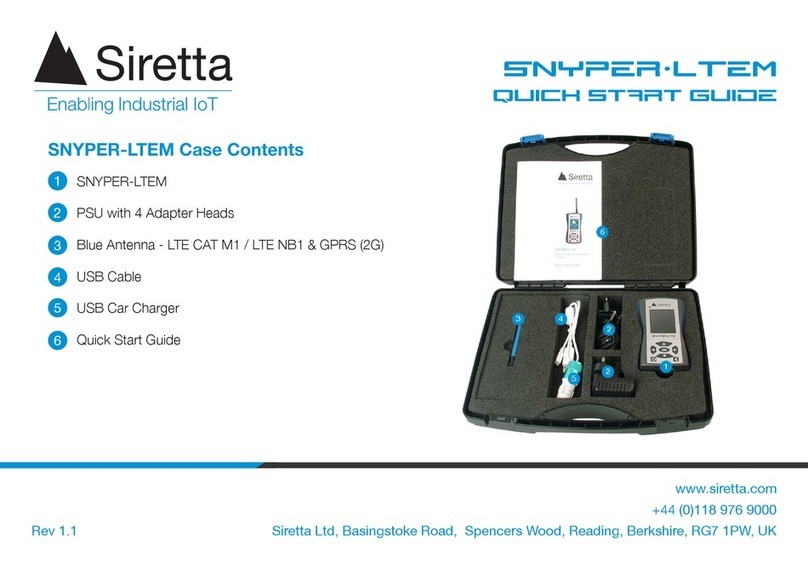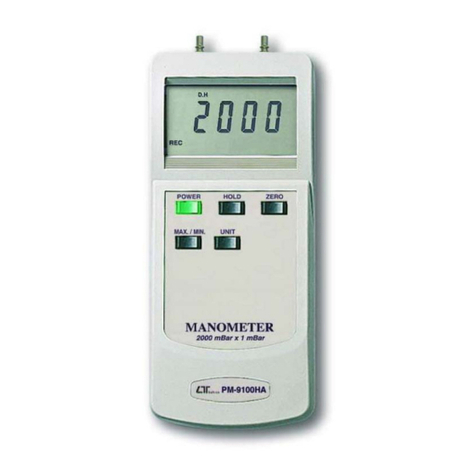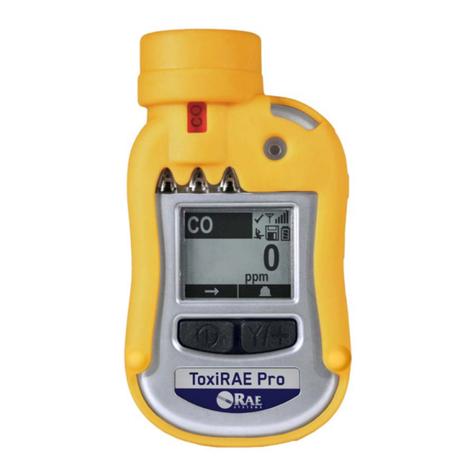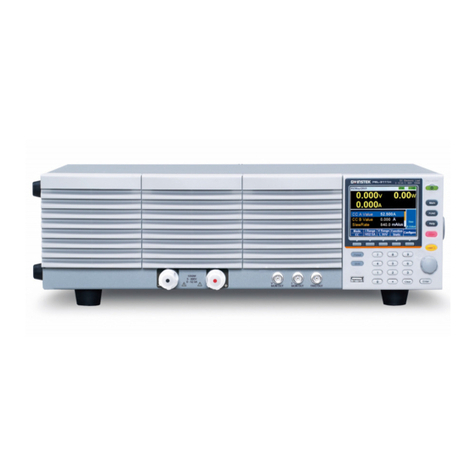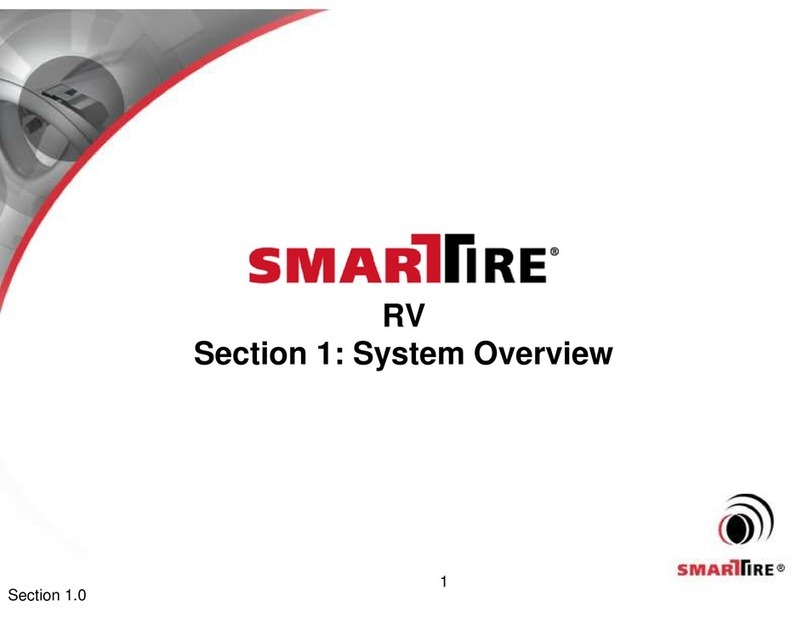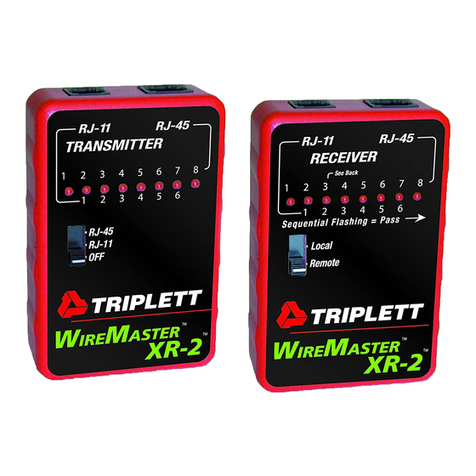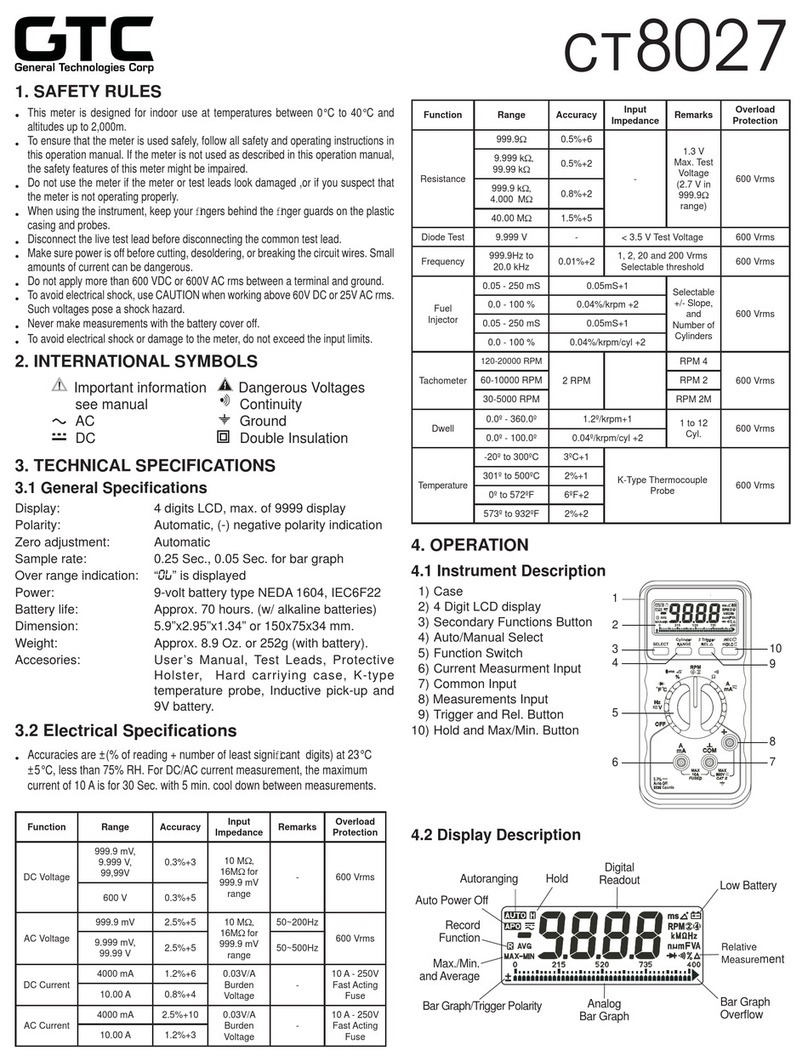STELMA SCI-1 Series User manual


CTM-2002,
iss.
3
MAY
1963
3.
Technical
Characteristics
Table
1
lists
technical
characteristics
of
the
SCI-1,
-IN,
and
-1P.
Table
1.
TECHNICAL CHARACTERISTICS
INPUT CURRENT
60-ma
de
neutral
signal
(SCI-1,
INPUT IMPEDANCE
INPUT
KEYING
SPEEDS
SCI-I
series
-
60
SCI-1
series
-75
SCI-1
series
-100
INPUT CIRCUIT
INPUT SIGNALS
PRESET DISTORTION
THRESHOLD
RANGE
INDICATION OF SIGNAL
DISTORTION
SCI-lN):
30 rna
de
polar
signal
(SCI-lP).
80
ohms
resistance.
60
wpm
-
or
any
22-millisecond
telegraph
signal.
75
wpm
-
or
any
17.
5-
millisecond
telegraph
signal.
100
wpm-
or
any
13.
5-mi_llisecond
telegraph
signal.
Isolated
from
ground
and
case.
May
be
positive
or
negative
battery,
grounded
or
floating.
10%
to
40%
Marking
or
Spacing
(adjustable).
Front-panel
lamp
goes
out
when
distortion
exceeds
preset
level.
DISTORTION THRESHOLD
:1:
3%.
ACCURACY
POWER REQUIREMENTS
ll5-volt
ac,
50/60
cycles,
1
watt.
DIMENSIONS
1-1/2
inches
by
5-3/4
inches
by
5
inches
over-all.
WEIGHT 2
pounds.
-2-

Chapter
2
INSTALLATION
4.
Unpacking
and
Checking
CTM-2~G2,
iss.
3
MAY 1963
Remove
the
SCI-1,
IN,
or
lP
from
the
cardboara
carton,
checking
the
outside
of
its
case
for
possible
dama;e
incurr-
ed
during
shipment.
The
unit
comes
packaged
w-h
four
wood
screws,
and
with
four
machine
screws
and
wsociated
fiber
lock-nuts,
so
that
the
equipment,
which
cont::.:1s
suit-
able
mounting
holes,
may
be
fastened
to
wood
or
natal,
res-
pectively.
5.
Mounting
The
best
location
for
mounting
the
SCI-1
series
ur..::
is
on
a
teletypewriter
table
or
console;
the
lamp may
fac:
upward,
with
the
power
cord
extending
from
the
bottom.
Skuld
the
overhang
of
the
table
top
to
be
too
great,
it
may
b:
:1ecess-
ary
to
mount
the
unit
on
its
side,
with
the
lamp
f-a=ing
for-
ward.
When
the
teletypewriter-table
or
console
m::unting
is
not
desirable,
any
location
permitting
the
attendmt
ready
access
to
the
indicator
lamp,
switch,
and
reset
bu::an
will
be
satisfactory.
The
unit
may
also
be
mounted
on
tie
wall.
6.
Connections
£_.
Plug
the
line
cord
into
a
115-vci..l-:
50/60
cycle
ac
power
receptacle.
Q..
The
SCI-1
and
the
SCI-IN
are
comected
in
series
with
the
telegraph
loop.
Since
polarities
murt
be
ob-
served
when
making
connections,
connect
the
neg:tive
side
of
the
loop
to
the
negative
(-)
screw
terminal
on
::te
rear
of
the
unit,
and
the
positive
side
to
the
(+)
terminal.
±.
ground
(G)
terminal
is
also
provided
on
the
terminal
board.
-3-

CTM-2002,
iss.
3
MAY
1963
NOTE:
PRINTER
MAGNET
COIL
LOOP
POLARITIES
INDICATED
ARE
FOR
NARK
CONDITION.
FIGURE
2.
SCI-IP.
POLAR
LOOP
CONNECnONS
£.•
For
the
SCI-lP,
which
must
be
in
series
with
a
30-ma
polar
telegraph
loop,
refer
to
figure
2
for
connec-
tions.
Connect
the
signal
side
of
the
loop
to
the
unit's
screw
terminal
marked
SIG,
and
connect
the
ground
side
of
the
loop
to
the
SIG GRD
screw.
A
screw
marked
CASE
GRD
is
also
available
and
may
be
used
to
tie
the
SCI-lP
to
the
common
station
ground
system.
NOTE
Do
not
connect
the
CASE
GRD
terminal
to
the
SIG GRD
termi-
nal.
7.
Speed
Conversion
2_.
Before
attempting
to
convert
a
unit's
speed,
re-
fer
to
Chapter
6
for
the
location
of
components
and
the
tech-
niques
to
be
employed
when
removing
them.
Q..
The
speed
at
which
an
SCI-1
series
unit
opera-
tes
is
determined
by
the
value
of
capacitor
C3,
located
be-
hind
ADJ SPACE
and
ADJ
MARK
variable
resistors.
To
change
speed,
replace
the
unit's
capacitor
C3
with
the
appropriate
one
of
the
following.
-4-

SPEED
60
wpm
75
wpm
100
wpm
NOTE
CTM-zo.:z,
iss.
3
MAY
1963
CAPACITOR
0. 68
ufd
0.
56
ufd
0. 39
ufd
After
a
speed
conversion,
the
unit
must
be
aligned
as
described
in
Chapter
5.
-5-

CTM-2002,
iss.
3
MAY
1963
Chapter
3
OPERATION
8.
Controls,
Indicators,
Connectors
The
·controls,
indicators,
and
connectors
mounted
on
each
SCI-1
series
unit
are
described
in
the
following
table.
Table
2. CONTROLS, INDICATORS,
CONNECTORS
Name
~
INDICATOR Amber
lamp
MARK-SPACE
Slide
switch
-6-
Function
Lights
once
the
PRESS
TO
RESET
button
is
operated
and
re-
leased,
remaining
on
as
long
as
satis-
factory
signals
are
received;
goes
out
when
spacing
or
marking
signal
dis-
tortion
is
greater
than
the
value
for
which
the
unit
is
preset.
Permits
monitoring
of
signals
for
either
marking
or
spacing
distortion.
Always
press
and
release
the
PRESS TO RESET
button
whenever
the
MARK-SPACE
switch
is
operated.
.;.·

PRESS TO
RESET
*ADJ
MARK
*ADJ SPACE
*60-MA
NEUT LOOP
(SCI-1,
-lN)
*30-MA
POLAR
LOOP
(SCI-lP)
Pushbutton
switch
Screwdriver
adjustable
variable
resistor
Screwdriver
adjustable
variable
resistor
Terminal
Board
Terminal
Board
CTM-2002,
iss.
3
~y
1963
Depression
and
release
resets
indicating
cir-
cuit;
when
held
in
depressed
position
INDICATOR
lamp
should
light
regard-
less
of
type
of
signal
being
received.
Permits
adjustment
of
marking-bias
distor-
tion
threshold.
Permits
adjustment
of
spacing-bias
distor-
tion
threshold.
Contains
screw
terminals
(for
marking
input
loop
connections)
marked
+
and
-
loop)
and
G
(case
ground).
Marked
SIG
GRD,
SIG
and
CASE GRD:
the
polar
signal
is
con-
nected
between
SIG
GRD
and
SIG,
observ-
ing
indicated
polar-
ity
(See
fig.
2).
*These
components
are
mounted
on
unit's
rear
panel.
9.
Operating
Principles
Each
of
the
SCI-1
series
units
indicates
telegraph
signal
deterioration,
by
extinguishing
an
indicator
lamp
whenever
-7-

I
t
I
'
-,
CTM-2002,
iss.
3
MAY
1963
Input
signal
distortion
{marking
or
spacing)
exceeds
preset
level.
The
SCI-I,
-lN,
or
-lP
establishes
the
length
of
a
standard
reference
pulse,
always
shorter
than
the
nominal
unit
pulse,
extinguishing
the
INDICATOR
lamp
whenever
a
unit
telegraph
pulse:
(1)
is
as
shortas
or
shorter
in
dura-
tion
thari
the
reference
pulse;
and
(2)
is
shortened
in
the
direction
corresponding
to
that
for
which
the
MARK-SPACE
switch
is
set.
The
distortion
threshold
at
which
the
INDI-
CATOR
lamp
goes
out
is
adjustable
by
means
of
two
vari-
able
resistors
{screwdriver
adjustments
at
the
rear
of
the
case).
ADJ
MARK
sets
the
threshold
for
marking
distortion
and
ADJ
SPACE,
for
spacing
distortion.
Effectively,
acti-
vation
of
the
SCI-1,
-lN,
or
-lP
circuit
alarm
depends
upon
the
amount
by
which
a
unit
pulse
is
shortened.
When
the
slide
switch
is
set
to
MARK,
activation
of
the
circuit
alarm
depends
upon
the
amount
by
which
unit
spacing
pulses
are
shortened
(i.
e:,
the
amount
of
mark-
ing
distortion);
when
the
slide
switch
is
set
to
SPACE
alarm
activation
depends
upon
the
amount
by
which
the'
unit
marking
pulses
are
shortened
(i.
e.
,
the
amount
of
spacing
distortion).
10.
Operating
Procedures
.2.·
Immediately
after
installation
as
described
in
Chapter
2,
the
SCI-1,
-lN,
or
-lP
is
operable
at
the
factory-set
distortion
threshold
of
20% (±5%).
(See
Chap-
ter
5
for
instructions
for
setting
the
desired
distortion
threshold.)
1?,.
In
operating
the
unit,
always:
(1)
Press
and
release
the
PRESS TO
RESET
button
several
times
successively
when
the
unit
is
first
put
into
operation,
and
whenever
the
MARK-SPACE
switch
is
operated.
(2)
Press
and
hold
down
the
PRESS TO
RESET
button,
to
check
that
the
INDICATOR
lamp
lights,
indicating
-8-

"
•
"
.
'
CTM-2002,
iss.
3
MAY
1963
that
the
unit
is
receiving
ac
power;
then
release
the
button;
f.·
Normally,
the
unit
is
not
used
until
garbled
copy
is
reported
(by
the
attendant
at
the
teletype
equip-
ment).
The
Serving
Test
Center
will
ask
the
teletype-
writer
attendant
to
do
the
following
while
copy
is
being
transmitted.
(1)
Press
and
release,
several
times
successively,
the
PRESS TO
RESET
button.
Does
the
INDICATOR
lamp
re-
main
On
or
Off
after
final
actuation
of
the
button?
NOTE
The
PRESS
TO
RESET
button
must
be
operated
a
few
times
in
per-
forming
this
check,
and
the
final
condition
of
the
INDICATOR
must
be
noted;
this
constitutes
an
ac
curate
indication
of
average
sig-
nal
distortion
existing
on
the
loop.
Checking
a
single
mark
or
space
pulse
does
not
give
an
accurate
indication
of
average
signal
dis-
tortion.
{2)
Operate
the
MARK-SPACE
switch
to
its
oppo-
site
position.
Is
the
switch
set
to
MARK
or
SPACE?
(3)
Repeat
step
(l),
above.
From
this
information
the
Service
Test
Center
can
quickly
determine
the
general
condition
of
received
signals
(
see
paragraph
11).
Generally
speaking,
if
the
INDICATOR
remains
On
after
several
successive
operations
of
the
PRESS
TO
RE-
SET
button,
the
trouble
is
at
the
receiving
station.
Ifthe
IN-
DICATOR
lamp
goes
Off,
the
quality
of
the
signals
being
re-
received
is
above
the
preset
distortion
threshold;
a
repair-
man
should
not
be
dispatched,
but
further
checks
should
be
made
of
the
transmission
facilities.
-9-

l
I
1
1
l
I
!
;
1
1
~
I
I
I
I
·
CTM-2002,
iss.
3
MAY
1963
11.
Signal
Condition
Chart
for
Serving
Test
Center
Table
3,
below
illustrates
how
the
SCI-1
series
indications
are
to
be
interpreted.
For
an
explanation
of
the
symbols
used
on
the
chart,
see
page
11
Table
3
SIGNAL
CONDITION
CHART
FOR
SERVING
TEST
CENTER
Subscriber
MARK-
INDICATOR
Trouble
in
Send
Reported
SPACE
Lamp
Subscriber's
Repair
Remarks
~
Switch
Condition
TTY
Rec'd
Man
Condition
Position
Unit
Signal
1.
Garbling
Space
Off.
Remains
off
when
RESET
is
pressed
-and
Predominance
of
released.
NO YES NO*
spacing
distortion
indicated.
Mark
On.
2.
Garbling
Space
On.
Predominance
of
I
!
Mark
Off.
Remains
NO YES NO*
marking
distortion
1
of!
when
RESET
indicated.
is
pressed
and
I
released.
3.
Garbling
Space
Off.
Remains
I
off
when
RESET
·is
pressed
and
released,
Indicates
predomi-
1
NO YES NO*
nance
or
distortion
Mark
Off.
Remains
other
than
simple
off
when
RESET
bias.
is
pressed
and
released.
4.
Inter-
Space
Off,
but
goes
on
:
mittent
or
when
RESET
is
Errors
Mark
pressed
andre-
Indicates
inter-
I
leased.
Goes
NO YES NO
mittent
distortion
off
again
about
hits.
same
time
sub-
scrlber
again
sees
error.
I
5.
Garbling
Space
Distortion
of
sig-
and
On.
YES**
NO**
YES**
nals
is
no
higher
1
Mark
than
20-25o/o,
which
a
printer
in
good
condition
should
!
accept.
6.
Inter-
Space
POSSI-
NO#
POSSI-
I
mittent
and
On.
BLY#
BLY#
Errors
Mark
'
_j
-10-

:,
~
'
*
*
$
CTM-2002,
iss.
3
MAY
1963
Explanation
of
Symbols
on
Table
3
After
all
possible
checks
of
transmission
facilities
are
made
and
no
trouble
is
found,
send
a
repairman
to
check
the
teletypewriter
subscriber
set,
if
one
is
involved.
**
There
could
be
an
occasion,
example
5.
when
a
subscriber's
copy
may
be
garbling
and
the
tele-
typewriter
machine
may
not
be
at
fault
(
e.
g.
,
if
the
transmission
tape
is
put
in
backwards
at
the
sending
end,
or
regenerative
repeater
is
send-
ing
signals
containing
errors
to
the
subscriber~
A
monitoring
printer
inserted
at
the
Serving
Test
Center
(STC)
can
be
used
to
check
either
possi-
bility)
a TMS
cannot
check
either
condition).
If
the
printer
copy
is
not
garbled,
it
definitely
indi-
cates
that
the
printer
at
the
subscriber's
station
should
be
checked
and
adjusted
by
a
repairman.
#
It
would
be
best
to
check
first
with
a
monitoring
printer
at
the
STC.
If
the
printer
at
the
STC
shows
no
errors
while
the
customer's
does
and
the
SCI-I
alarm
light
remains
on,
a
repairman
should
be
sent
out
to
check
the
subscriber's
machine.
-11-

CTM-2002,
iss.
3
MAY
1963
Chapter
4
THEORY
OF
OPERATION
12.
General
The
following
text
describes
the
SCI-1,
-lN,
and
-lP
cir-
cuit
functions,
power
supply
operation,
and
indicator
lamp
functions.
Figure
3.
(block
diagram)
and
figure
4
(waveform
diagram)
are
applicable
to
all
three
units;
fig-
ures
5
(SCI-1),
6
(SCI-IN),
and
7
(SCI-lP)
are
schematic
diagrams.
Slpl
lllpu.t
J4J, J4J.
llart
Space
FIGURE 3.
SCI-1,
-lN,
-lP:
BLOCK
DIAGRAM
13.
Circuit
Functions
A• INPUT CIRCUIT.
(1) The SCI-1
or
SCI-lN
input
circuit
which
accepts
60-ma
neutral
signals
(figure
4,
line
1),
removes
any
transient
holes
or
spikes
which
may
be
present
in
the
signal.
The
SCI-lP
input
circuit
accepts
30-ma
polar
sig-
nals
from
which
it
removes
transient
holes
or
spikes.
(2)
The
shaped
signal
is
regenerated
by
a
trigger
stage
(transistors
Ql
and
Q2)
from
which
two
out-
puts
are
taken.
In
the
SCI-1
or
SCI-lN,
the
trigger
stage
is
activated
at
the
half-current
point
of
the'
neutral
input
signal.
-12-

,;
CTM-2002,
iss.
3
MAY
1963
The
SCI-lP
trigger
is
biased,
by
two
resistors,
to
trigger
at
the
zero-current
point.
The
original
signal
is
reproduced
and
reshaped
from Q2,
to
provide
sharp
mark-space
and
space-mark
transitions.
The
output
of
Ql
is
an
inversion
of
the
Q2
output
.
.Q..
REFERENCE PULSE GENERATION.
Trigger
circuit
outputs
from Q2
are
applied,
via
a
reversing
switch
(MARK-
SPACE),
to
a
differentiating
circuit
and
to
the
monos
table
reference
pulse
generator
(Q2
and
Q4)
as
trigger
pulses.
The
reversing
switch
permits
the
reference
pulse
to
be
gen-
erated
on
either
a
space-to-mark
transition
or
mark-
to-space
transition
of
the
input
signal
(figure
4,
line
2)
,
thereby
defining
either
marking
or
spacing
pulse
widths.
The
switch
reverses
the
polarity
of
the
signal
applied
to
the
differentiating
circuit,
whose
output
is
applied
to
coinci-
dence
stage
Q6.
The
reference
pulse
generator,
which
can
be
adjusted
for 60%
to
90%
of
a
normal
pulse
width,
is
factory
adjusted
at
STELMA
for
80%
of
normal
width,
cor-
responding
to
acceptance
of
signals
containing
up
to
20%
diS'tortion.
£·
COINCIDENCE CIRCUIT OPERATION.
The
co-
incidence
circuit
contains
transistors
QS,
which
receives
dir!=!ctly
coupled
negative
output
pulses
from
the
mono-
stable
reference
pulse
generator,
and
Q6,
which
receives
(via
the
reversing
switch
and
a
differentiating
network)
the
input
signal
pulses
from
trigger
Ql.
The
coincidence
circuit
produces
an
output
only
when
the
bases
of
QS
and
Q6
are
simultaneously
negative,
a
condition
occurring
any
time
that
signal
distortion
exceeds
the
unit's
preset
level.
Transistors
QS
and
Q6
supply
their
negative
output
pulse
{figure
4,
line
4)
to
the
memory
circuit
whenever:
(1)
The
input
signal
mark
pulse,
during
spac-
ing
distortion
measurement,
is
shorter
that
the
negative
~
reference
pulse
applied
to
the
QS
base
{figure
4,
line
2);
consequently,
the
negative
pulse
produced
by
the
differen-
tiating
network
in
response
to
the
incoming
signals
mark-
to-space
transition,
drives
the
base
of
Q6
negative
(figure
4,
line
3)
while
the
QS
base
is
negative.
-13-

CTM-200:0,
iss.
3
MAY
1963
(2)
The
input
signal
space
pulse,during
mark-
ing
distc::-"J.on
measurement
is
shorter
than
the
negative
referenc:;
;ulse
applied
to
Q5
(figure
4,1ine
2);
as
a
resul~
the
diffe::-::J.tiating
circuit's
negative
pulse,
in
response
to
the
inpu!
signal's
space-to-mark
transition,
drives
the
Q6
base
ne;-:.:ive
(figure
4,
line
3)
while
the
Q5
base
is
nega-
tive.
As
Iong
as
the
reference
pulse
(figure
4,
line
2)
is
shorter
t::::.n
the
incoming
mark
or
space
pulse,the
negative
reference
pulse
is
removed
from
the
Q5
base
before
the
Q6
base
go:;.:
negative
in
response
to
a
transition
(figure
43
line
3);
cons:·~.rently,
no
output
is
produced
by
the
coincidence
circuit
(::.;ure
4,
line
4).
1.
Sipa.l
Input
2.
Reference
hlse
3.
Output
of
Differentiatint
Network
4.
Coinc!dencl!
Output
I I
'/////,t
'////~
'7
---w.f~~~~ce
-y&'!~
l f
Space
P'&?P
~
_,_.
1
~
-
..
~--
1 c:::.Y.illJa
' ' I I I I I I
~~I~
ir-
.-i
ir-
l__j
: I
L...iJ
I
L_jj
I I t I 1 1 I I
' I I I ' I I I
++
i-H-
i
++-
• I I I 1 I t I
I
--+---y--
I
--+---V-
Zero
Bias
Signal
I
251o
1
Spacing
Bias
Signal
, 25%
~king
'Bias
Signal
3"evers1Dg
Switch
on
Mark
;Reversing
Switch on
Space
I
Reversing
Swllch
on
MArk
FIGURE
4.
SCI-1.
-lN,
-lP:
WAVEFORM
DIAGRAM
:Q..
SIGNAL DISTORTION INDICATIONS.
The
memory
circuit,
:
bistable
multivibrator
(Q7
and
QS)
which
is
placed
1:-.
one
of
its
stable
states
by
manual
depression
of
PRESS
TC
.?..ESET
pushbutton,
controls
the
operation
of
tran-
sistor
Q2~
which,
in
turn,
determines
the
condition
of
the
INDICA'I'CR
lamp.
(1)
As
long
as
the
input
signal
distor-
tion
lev::
is
acceptable
(L
e.,
no
output
from
the
coinci-
dence
c:.~~uit),
Q8
conducts
and
Q7
is
cut
off
with
Q8
con-
ducting,
:ts
low
negative
collector
potential
keeps
Q9
cut
off.
Bec.:.:.:se Q9
shunts
the
neon
INDICATOR
lamp,
the
lamp
is
l:;hted
as
long
as
Q9
is
cut
off,
therebyindicating
accepta:-.:.:
signals.
-14-

CTM-2002,
iss.
3
MAY
1963
(2)
When
distortion
in
the
signal
exceeds
the
preset
level,
coincidence
occurs.
The
output
negative
pulse
from
QS
and
Q6
causes
the
memory
bistable
to
change
state,
cutting
off
Q8
so
that
its
collector
voltage
goes
sufficiently
negative
to
force
Q9
into
conduction,
causing
the
neon
INDICATOR
lamp
to
go
off
(
indicating
that
the
in-
put
signal
has
exceeded
the
preset
distortion
limits).
The
lamp
remains
off
until
the
front-panel
PRESS
TO
RESET
but-
ton
is
depressed,
which
causes
Q8
to
conduct,
qJ
to
cut
off,
and
the
INDICATOR
lamp
to
light.
14.
Power
Supply
-
SCI-1,
-1N,
-1P
The
unit's
power
supply
circuits
provide
two
outputs.
One
half-wave,
rectified,
filtered
output
supplies
a
negative
voltage
(approximately
-20
volts)
to
the
collector
of
all.
transistors
but
Q9. The
other
half-wave
rectified,
unfiltered
supply
(approximately
-45
volts)
is
for
the
neon
indicator
and
for
the
collector
of
output
transistor
Q9.
15.
INDICATOR
Lamp
The
SCI-1,
-lN,
or
-lP
front-panel
neon
lamp:
(1)
serves
as
a
pilot
indicator,
lighting
(regardless
of
signal
distortion
condition)
whenever
the
PRESS
TO
RESET
button
is
pushed
and
held
down,
thereby
indicating
that
the
equipment
is
properly
energized;
and
(2)
indicates
the
signal
dis-
tortion
condition
(marking
or
spacing)
that
exists
on
the
loop.
Failure
of
the
lamp
to
remain
lighted,
after
resetting,
de-
notes
that
distortion
on
the
telegraph
loop
has
exceeded
the
unit's
preset
limits.
(In
order
to
be
certain·
that
neither
ex-
cessive
marking
nor
spacing
distortion
exists
on
the
loop,
it
is
necessary
to
test
with
the
MARK-SPACE
switch
in
both
positions).
-15-

r7
•.
:J
0
N
I
5~
1/MlOYIQ
OLI.YYi3HOS
'(MO'I3B
QNV
665UiS)
1-108
'S illlfiDid
'M111W
IJIJII4HIIIJ
UlMISlO
c=J
't
·Mill
Ill
ln
U*'lllfiU
'SMIII
•t
Ill'
1))111'1SIIH
Tft
OlUil341 lfiiiUHJ.O
SUWI
'(
'1WH......_IMS1111111110(.'l
NOOIIOJGJII"'
lloiiiUIIOJil.t'l"'
.....
"
....
'"'
.,
1n1•
0£
••
m
I
ln~~
lO
....
I
••
El
..
13
001

I
.....
-..:s
I
l±l
B
IE
••
IlK
.,
IlK
5Plt.C£,.. _..MARK
('-----,--------
' '
' '
\ \
SI•A
NOTE
4 '
.,
30
.,
••
NOTES:
•••
...
••
20K
1.
.6
8 UF FOR
60
WPM
.56
UF FOR 75 WPM
.39
UF FOR
100
WPM
C2
220
NOTE
6
2. UNLESS OTHERWISE SPECIFIED
ALL
RESISTANCES
ARE
IN
OHMS,
CAPACITANCES
ARE
IN UUF.
3.
=DESIGNATES
EQUIPMENT
MARKING.
4.
FOR UNITS SERIAL-NUMBERED
7274
AND
ABOVE,
Q1
THROUGH Q8
ARE
TYPE
ST-123.
5. FOR UNITS SERIAL-NUMBERED
7274
AND
ABOVE,
C5
IS ELIMINATED.
6. FOR UNITS SERIAL-NUMBERED
7274
AND
ABOVE,
C?
'11\LUE
IS
1500.
FIGURE
6.
BCI-lN
(8Nl600
AND
ABOVE),
BCHEMmC
DIAGRAM
NOl'E 5
~~·
I
N
0
0
N
....
C1l
1-'C/l
(,J).
())
ww

I
......
CD
I
~
IEl
A-i
••o
IlK
AI
••
III
.L-eo
25V
T+IOUf
NOTE 7
>
••
30
(NOT£3}
7e
~
~~~\--~~Fj
C9
,05Uf
n:
"'
••
{NOTE:S
2AN06)
•••
IlK
M
NOTES:
&At.CE+
...,MARK
"'-----,--------
\ \
\ \
\ \••·•
••
20K
NOTE 9
!,
.68
UFO
FOR
60 WPM
.56
UFrJ FOR 75 WPM
.39
UFO
FOR
100
WPM
2. R36
FACTORY
SELECTED.
3.
SER. NO.
ABOVE
3000
ONLY.
••
15K
4,
UNLESS OTHERWISE SPECIFIED
ALL
RESISTANCES
ARE
IN
OHMS,
CAPACITANCES
ARE
IN
UUP.
5.
t:=:::::J
DESIGNATES EQUIP:MENT MARKING.
6. R36
IS
500
OHM
VARIABLE
RESISTOR
ON
UNITS
SERIAL-NUMBERED
5501
AND ABOVE.
7.
FOR UNITS SERIAL-NUMBERED
7274
AND
ABOVE,
01
THROUGH
08
ARE
TYPE
ST-123.
8.
FOR UNITS SERIAL-NUMBERED
7274
AND
ABOVE,
CS
IS
ELIMINATED.
9.
FOR UNITS SERIAL-NUMBERED
7274
AND
ABOVE,
C2
VALUE
IS
1500.
115YAC
OOCPS
.
..
...
R20
'"
•"
j6AMP
FIGURE 7.
SCI-IP
(8Nl600
AND
ABOVE),
SCHEMATIC
DIAGRAM
TO
STELMA
A2386
~~6
~~~~
I 3
Mi
1
.,
"'
.,
'"
A~;~
~~~
+1.,~~,
25V
~Q
><:~
I
""
'-'
..
~.~·4
....
Ul
~Ul
0'>
(.,.)(.,.)

Chapter
5
ALIGNMENT
16.
General
CTM-2002,
iss.
3
MAY
1963
The
SCI-1
series
units
may
be
aligned
to
indicate
distor-
tion
(marking
and
spacing)
above
a
threshold
adjustable
from 10%
to
40%.
Polar
units
above
serial
number
5500
re-
.require
an
additional
alignment(in
the
input
circuit)to
assure
that
the the
unit
triggers
symmetrically.Both
adjustments
should
be
checked
periodically
or
whenever
components
of
the
unit
are
changed.
17.
Alignment
Setup
To
adjust
the
triggering
circuit
of
an
SCI-lP
(serial
number
above
5500),
set
up
the
equipment
as
indicated
in~below;
to
set
the
distortion
threshold
of
all
SCI-1
units,
setup
the
equipment
as
indicated
in
.Q
below
•
..£.:.
TRIGGER ADJUST SETUP.
(1}
The
test
equipmen
ts
required
are:
@)
1
de
current
generator,
0
to
::1::
10-ma,
with
metered
output.
(g)
1
multimeter,
Simpson
Model270
or
equivalent.
(2)
Connect
the
current
generator
ground
and
::1::
lead
to
the
SCI-lP
SIG GRD
and
SIG
terminals,respective-
ly.
.Q.
THRESHOLD
ADJUST
SETUP.
(1}
The
test
equipments
required
are:
@)
a
distorting
pattern
generator
such
-19-

CTM-2002,
iss.
3
MAY
1963
as
Distorting
Pattern
Generator,
STELMA
Model
PG-105
(DAC-V).
(9)
a
distortion
analyzer
such
as
Di-
gital
Distortion
Analyzer,
STELMA
Model
DD-S
(DAC-V) ,
or
Telegraph
Distortion
Analyzer,
STELMA
Model
TDA-2,
and
(g) a
multimeter,
Simpson
Model270
or
equivalent.
(2)
Connect
pattern
generator
output
(fig.
8)
in
series
with
the
SCI-1
and
the
appropriate
dummy
load
resistor
(resistance
of
dummy
load
determined
by
required
input
current
of
SCI-1
under
test).
Connect
the
TDA-2
in-
put
across
the
dummy
load
resistor.
PATTERN
~
DISTORTION
GENERATOR
ANALYZER
SCI-I
MGURE 8.
SCI-1
SERIES, AIJGNMENT
SETUP
18.
Alignment
Procedures
g..
SYMMETRICAL
TRIGGER
ADJUST
(POLAR UNITS
ABOVE
SN
5500).
NOTE
The
INDICATOR
lamp
must
be
lighted
during
all
trigger
ad-
justments.
-zo~.
:•
..:
This manual suits for next models
2
Table of contents
Popular Measuring Instrument manuals by other brands
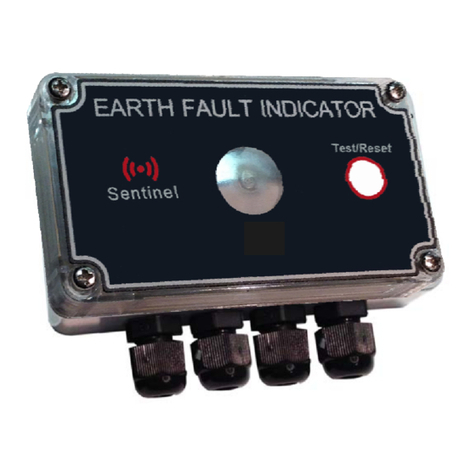
Cybertronix
Cybertronix Sentinel EFI-MFZ-50 user manual
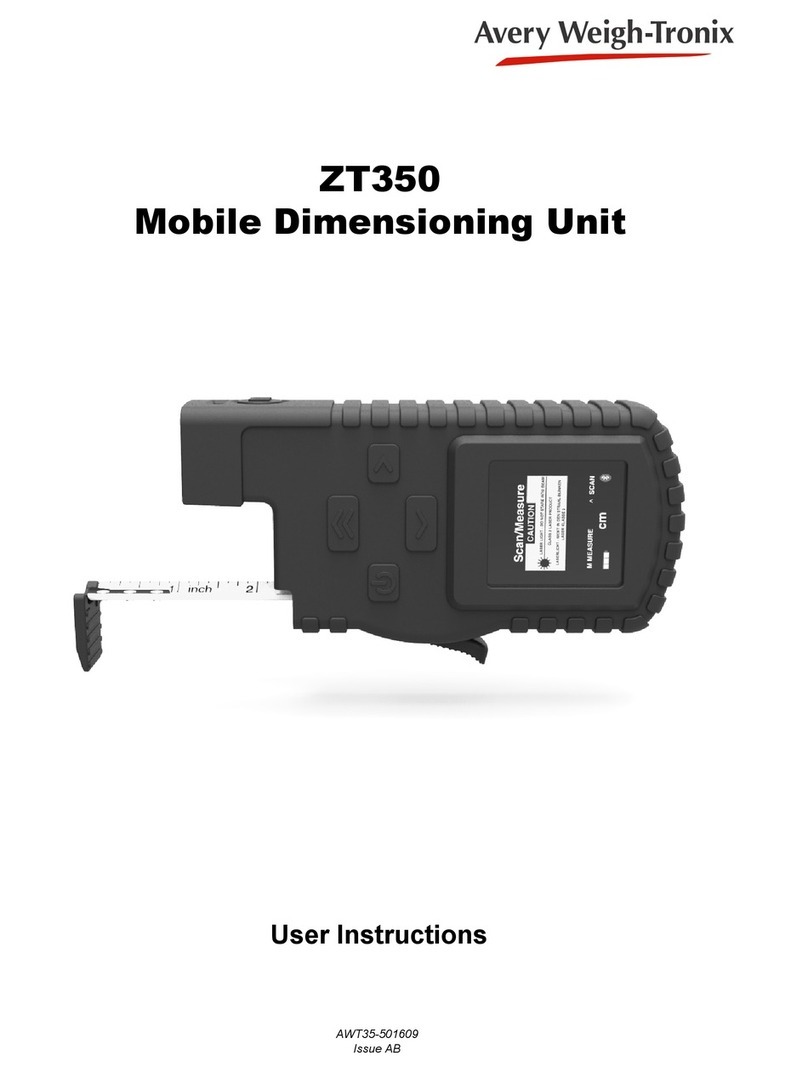
Avery Weigh-Tronix
Avery Weigh-Tronix ZT350 User instructions

AgaMatrix
AgaMatrix WaveSense JAZZ Getting started

Omntec
Omntec FuelCheck Installation & operating manual

Digi
Digi Connect Tank Getting started guide
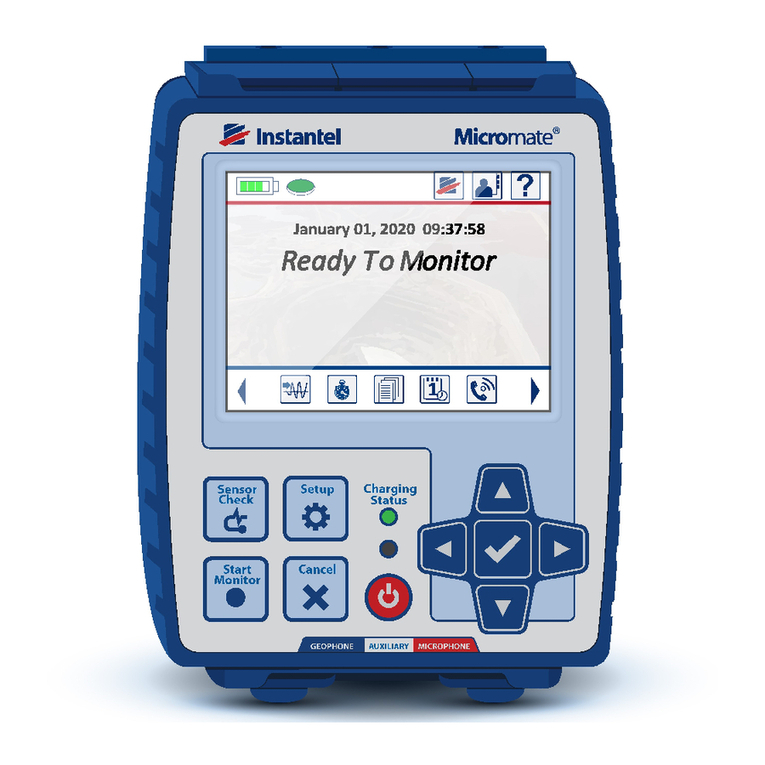
Instantel
Instantel Micromate owner's manual
